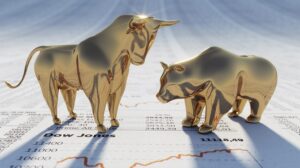The US stock market is a dynamic and complex entity that involves numerous terminologies and jargon. For beginners and even experienced investors, understanding these terms is crucial for effective decision-making and navigating the market with confidence. In this article, we will demystify some of the common terminologies used in the US stock market, providing clarity and enhancing your understanding of the investment landscape.
Stock
A stock represents a share of ownership in a company. When you buy a stock, you become a partial owner of that company and are entitled to a portion of its profits and potential capital appreciation.
Stock Exchange
A stock exchange is a marketplace where buyers and sellers come together to trade stocks. In the US, prominent stock exchanges include the New York Stock Exchange (NYSE) and the Nasdaq.
Ticker Symbol
A ticker symbol is a unique combination of letters representing a particular stock. For example, Apple Inc. has the ticker symbol “AAPL.” Ticker symbols are used to identify and track stocks.
Bull Market
A bull market refers to a market condition characterized by rising stock prices and overall optimism among investors. It signifies a period of economic growth and investor confidence.

Bear Market
A bear market is the opposite of a bull market. It refers to a market condition marked by falling stock prices and widespread pessimism. In a bear market, investors are generally more cautious and expect further declines.
Market Index
A market index is a statistical measure that tracks the performance of a specific group of stocks. Popular market indices in the US include the S&P 500, Dow Jones Industrial Average (DJIA), and Nasdaq Composite Index. These indices provide a snapshot of the overall market and serve as benchmarks for investors.
Volume
Volume represents the total number of shares traded during a specific period. It indicates the level of activity and liquidity in a particular stock. Higher volume usually suggests greater investor interest and can impact stock price movements.
Dividend
A dividend is a portion of a company’s profits distributed to its shareholders. Dividends are typically paid on a regular basis and can provide investors with a steady income stream.
Market Capitalization
Market capitalization, or market cap, is the total value of a company’s outstanding shares. It is calculated by multiplying the current stock price by the number of shares outstanding. Market cap categorizes companies into different sizes, such as large-cap, mid-cap, and small-cap, which reflect their overall market value.
Price-to-Earnings Ratio (P/E Ratio)
The price-to-earnings ratio (P/E ratio) is a valuation metric that compares a company’s stock price to its earnings per share (EPS). It helps investors assess whether a stock is overvalued or undervalued. A high P/E ratio may indicate that investors have high expectations for future earnings growth, while a low P/E ratio may suggest the stock is relatively cheap.
Earnings Per Share (EPS)
Earnings per share (EPS) is a measure of a company’s profitability. It represents the portion of a company’s profit allocated to each outstanding share of common stock. EPS is an essential factor considered by investors when evaluating a company’s financial performance.
Volatility
Volatility refers to the degree of price fluctuations in a stock or the overall market. High volatility indicates significant price swings, while low volatility suggests more stable and predictable price movements. Volatility can present both risks and opportunities for investors.
Blue-Chip Stocks
Blue-chip stocks refer to shares of well-established, financially stable companies with a history of reliable performance. These companies are often leaders in their industries and have a track record of paying dividends.
Sector
A sector refers to a specific segment of the economy that consists of companies operating in a similar industry. Common sectors include technology, healthcare, finance, consumer goods, and energy. Understanding sectors can help investors identify trends, evaluate opportunities, and diversify their portfolios.
Order Types
Order types are instructions given by investors to buy or sell stocks. Some common order types include market orders, limit orders, stop orders, and stop-limit orders. Market orders are executed at the current market price, while limit orders allow investors to specify the maximum price they are willing to buy or sell a stock. Stop orders trigger a market order when a stock reaches a specified price, and stop-limit orders combine stop and limit orders.
Brokerage Account

A brokerage account is an investment account that allows individuals to buy and sell stocks and other securities. Brokerage firms provide access to the stock market and offer various services, including trade execution, research, and account management.
Portfolio
A portfolio is a collection of investments held by an individual or an entity. It includes stocks, bonds, mutual funds, and other assets. Building a well-diversified portfolio is crucial for managing risk and maximizing returns.
Risk-Return Tradeoff
The risk-return tradeoff is the concept that higher potential returns come with higher levels of risk. Generally, riskier investments have the potential for greater gains but also a higher chance of losses. It’s essential for investors to assess their risk tolerance and choose investments that align with their financial goals.
Fundamental Analysis
Fundamental analysis involves evaluating a company’s financial health, including its revenue, earnings, debt levels, management, competitive position, and industry trends. Investors use this analysis to determine the intrinsic value of a stock and make informed investment decisions.
Technical Analysis
Technical analysis involves studying past price and volume patterns of stocks to forecast future price movements. It uses tools like charts, trend lines, and technical indicators to identify trends, support, and resistance levels. Technical analysis aims to identify buying and selling opportunities based on historical price patterns.
Market Order vs. Limit Order
A market order is an instruction to buy or sell a stock at the best available price in the market. It ensures immediate execution but may result in a slightly different price than anticipated. A limit order, on the other hand, sets a specific price at which an investor is willing to buy or sell a stock. It guarantees the desired price but may not be executed if the market does not reach that price.
Conclusion
Understanding the terminologies used in the US stock market is essential for investors to make informed decisions and navigate the complexities of the investment landscape. This article has covered some of the key terms, including stock, stock exchange, bull and bear markets, market indices, dividends, market capitalization, P/E ratio, EPS, volatility, sectors, order types, brokerage accounts, portfolios, risk-return tradeoff, fundamental and technical analysis, and market orders versus limit orders.
By familiarizing yourself with these terms, you can enhance your knowledge and confidence in investing. However, it’s crucial to continue learning, conduct thorough research, and seek professional advice when needed. With time and experience, you’ll become more proficient in understanding and utilizing these terminologies to make informed investment decisions and achieve your financial goals in the US stock market.










3 Comments